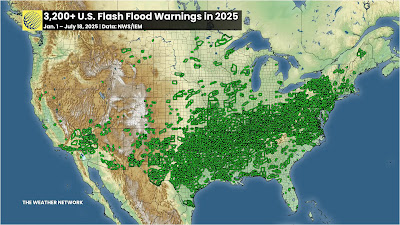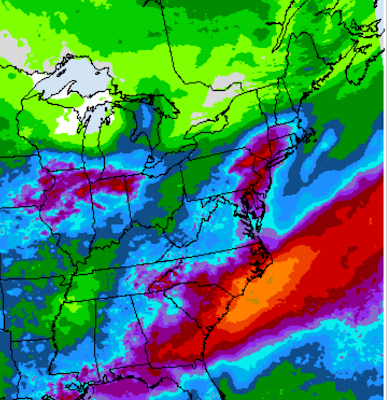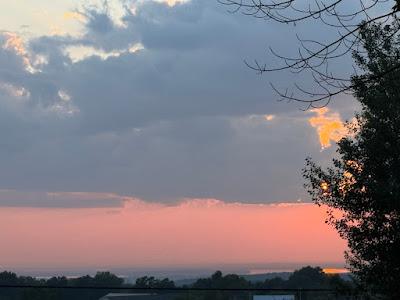 |
Flash flood damage in Sutton, Vermont on July 10.
This summer has brought an extraordinary
number of flash floods to the U.S. Get used to it,
as this is the new climate change normal. |
The news of deadly, terrible floods have been coming at us pretty much daily lately.
It's the Summer Of Floods.
And I'll get this out of the way right now. Yes, climate change is much share in the blame for all this. A warmer atmosphere can hold more moisture than a cooler air. That extra warm air moisture is increasingly wrung out in extreme fashion if a summertime weather disturbance bumps into it.
The Atlantic Ocean and Gulf of Mexico are both warmer than average, due again in large part due to climate change. Some of that warmer water evaporates into the air, which flows inland as exceptionally humid air, ripe for producing extraordinary downpours.
This isn't going away. And neither is the death, heartache, hardship and sadness the floods bring. Moreover, we're not ready for these things, and not ready for when they get worse. Which will happen.
On top of all that, the political climate in the U.S., such as it is, is not at all conducive for dealing with our new reality.
What follows is our situation, and it isn't pretty.
THE FLOODS
July began with the extreme Texas floods that are known to have killed at least 135 people. Floods and debris flows swept Ruidoso, New Mexico on July 8, killing three people. Another four people died in North Carolina flooding on July 6.
Davenport, Iowa endured a flash flood emergency on July 11. Another huge flash flood hit New Jersey and the New York City metro area on July 14 claiming an additional two lives. Flash flooding from five inches of rain returned to parts of New Jersey on July 20.
Other dramatic floods have hit the western Chicago suburbs (July 8 ), the Kansas City area (July 17) parts of Virginia, (July. 18), the northern suburbs of Washington DC on July 19 and Overland Park, Kansas on July 21, where one person died.
In the United States, flood deaths last year and this year are far above the annual average of 85. In 2024, the U.S. saw 145 flood-related deaths. The nation saw at least that many deaths from flooding just this month, never mind the whole year.
The sheer number of floods this month have been staggering.
Through mid-month, the National Weather Service had issued more flash flood warnings in the United States than in any year since at least 1986. When I last checked a couple days ago it was at least 3,360 such warnings and counting.
Here in Vermont, we've so far escaped the worst of it, but we've still dealt with damaging flash floods this year. On May 17, there was quite a bit of flash flooding in towns like Warren, Waitsfield and White River Junction.
Parts of the Northeast Kingdom were slammed by flash floods on July 10, seriously damaging some homes and several roads.
TOO WET, TOO WARM
The bottom line of this summer is it's been too warm, and especially too humid.
Per the Washington Post
"A Washington Post analysis of atmospheric data found a record amount of moisture flowing in the skies over the past year and a half, largely due to rising global temperatures.
With so much warm, moist air to fuel storms, they are increasingly able to move water vapor from the oceans to locations hundred of miles from the coast, triggering flooding for which most inland communities are ill-prepared.
'We're living in a climate that we've never seen, and it keeps throwing us curveballs,' said Kathie Dell, North Carolina's state climatologist. 'How do you plan for the worst thing you've never seen?'"
Most places aren't ready for this new, wet reality. Many coastal areas have elaborate systems to evacuate people and bolster defenses against severe storms and hurricanes, which have always been a hazard near the shore.
 |
Each tiny green box in this map is one of the flash flood
warnings issued between January 1 and July 18 this year
Source: The Weather Network. |
Inland states, cities and towns are not as prepared for the extremes like the newly ferocious floods that now strike places like they did in western North Carolina during last September's Hurricane Helene, and the tragic floods in the Texas Hill Country in early July.
We keep hearing these floods described as one in 1000 year events. That means there's just a 0.1 percent chance of that event happening in that place in any given year.
However as CNN explains:
"But climate change is losing the dice in favor of extreme precipitation.
'When we talk about e.g. 1,000 year events, we're talking about the likelihood of these events in the absence of human-caused warming (i.e, how often we would expect the from natural variability alone),' said climate scientist Michael Mann of the University of Pennsylvania. 'These events are of course much more frequent 'because' of human-caused warming,' he said in an email."
As the Washington Post points out, for every 1 degree Celsius (1.8 degrees Fahrenheit) of warming air is capable of holding 7 percent more moisture.
That moisture has to go somewhere. Hence the floods, Some climate scientists also increasingly think weather patterns can get "stuck" in place more often, due to climate change.
CNN continues:
"A recent study Mann worked on found such weather patterns have tripled in incidence since the mid-with century during the summer months. The problem is these patterns are 'not necessarily well captured in climate models' he said. This increases uncertainty about future projections for extreme weather events."
WHAT TO DO?
This trend toward more and worse floods will only continue.
Sure, some summers in the United States and elsewhere will be drier than this one. A few future summers will feature punishing droughts. After all, depending on the prevailing weather patterns of the season, winds could come from dry sources like central Mexico, or the Desert Southwest.
But overall, we are now permanent stuck in a world that floods more easily and more dramatically than ever before. And it will get worse.
We are not ready for that.
As the Washington Post quoted:
"'Any given community can't know if it's going to be the next one that's going to have a flood that is orders of magnitude larger than the largest flood they've known,' said disaster researcher Rachel Hogan Carr, who co-chairs a World Meteorological Organization project aimed at improving flood warnings. 'But we must all know now that we should be prepared.'"
One reason so many people died in Hurricane Helene - and the mega flood earlier this month in Texas, is that people couldn't imagine things would get that bad. And plans were not necessarily in place to deal with it.
In western North Carolina, perhaps not enough people fled from the impending danger from the floods, as the Washington Post reported:
"Though the National Weather Service correctly predicted that the flooding would be deadly, the warnings from local authorities were not forceful or specific enough to sway residents who never imagined a hurricane could hurt them so far from the sea."
The same problem came with the Texas flood. Meteorologists accurate predicted the torrential rains that brought the floods. But authorities didn't order evacuations in many of the hardest hit areas. And warnings didn't reach many until it was too late to flee. Some of those people died.
The lesson: Detailed disaster plans need to be established, ones that take the warnings from the National Weather Service and get them to the people who need to hear them. And somehow, the public needs to be trained to heed these flash flood warnings, and know how to get out of the way quickly.
I'm not optimistic we can get there anytime soon, given the Trump-era cutbacks and the National Weather Service and their laissez-faire approach to emergency management.
THE AFTERMATH
For flood survivors, the mega floods leave incredible destruction that threaten the very existence of their communities.
An example is Ellicott City, Maryland, a charming, old small city not far west of Baltimore, was devastated three times within a decade, first in 2011, then an even worse flash flood in 2016 and then the worst of them all in 2018,
Once again, it rained hard in Ellicott City a couple weeks ago and the dreaded flash flood warnings were issued. Nearly 3.5 inches of rain pounded the community within three hours on July 13. Another 1.5 inches fell in less than an hour the next day. That's close to the amount of rain that devastated Ellicott City in 2018.
"When it rains like it did Monday and Sunday, a wave of fear comes over business owner Cindi Ryland told CBS Baltimore. 'What we go through here every time it rains, we all just hold our breath,' Ryland said. 'It's frightening, but we're here and we're resilient."
This time, the water caused only minor damage, But only because of some painful and very expensive redesigns and rethinking in Ellicott City.
Per CBS Baltimore:
"The projects include five retention ponds, two of which are complete, and two water conveyance project, Those include a series of culverts under Maryland Avenue and the North Tunnel project
The third retention pond is expected to be up and running in the fall. The North Tunnel is expected to be complete by fall 2027 while the culvert are in their final design stage"
The changes already completed were apparently enough to prevent another catastrophic flood in Ellicott City this time.
But the project came at a big financial and community loss, Ellicott City had to tear down four historic buildings. The cost is estimated at $130 million, which includes a $75 million loan from the federal Environmental Protection Agency and $20 million from the state of Maryland.
This is just one community. Imagine how much it will cost to project dozens, or hundreds, or thousands of communities from the new flood regime we're under.
There's echoes of Ellicott City parallels Vermont communities like Barre, hit hard by floods in both 2023 and 2024.
The 2023 flood damage 350 properties were damaged. Barre, among other things has been looking at buyouts.. Sixty-seven property owners jumped at the chance to sell their flood-prone properties.
Those properties would be razed, and the remaining land would just become open floodplain. Maybe parks or farmland, but no houses, no commercial structures.
This type of buyout, though, is painful to the communities involved. With each demolished house, Barre would lose some of its tax base. Right when the cash-strapped city is also trying to pay for flood recovery.
It got so bad, that Barre rejected some applications for the buyouts. Barre's city manager said approving all the buyouts would have gotten rid of roughly $280,000 in property tax revenue.
Barre isn't a rich little city either, About a quarter of the residents are at or below the poverty level. Plus Barre needs more housing, not less. At last report, the city rejected 40 of the 27 buyout requests.
Now imagine how many Barres are out there. It's challenging!
NO TRUMP HELP
To make things worse, the Trump administration is clawing back money set for these flood mitigation projects. Basically, since Trump doesn't think climate change exists, there's no need for the funding.
It also interesting that Trump signed this into law back in 2018 and now he's dumping the idea
Virtually all climate scientists disagree with Trump, but the narcissist in chief insists he's always right, so there you go.
Anyway, 20 states, including Vermont, are suing the Trump administration's decision a couple months back to end a multi-billion dollar federal program that helps communities gird themselves against future floods as Vermont Public reports.
The program is called Building Resilient Infrastructure and Communities (BRIC). It covered as much as 90 percent of the cost of things like restoring floodplains, expanding and improving culverts and bridges and protecting wastewater and drinking water treatment plants
It looks like Vermont was supposed to get about $5 million in funding through BRIC this year to fund 36 projects around the state.
So, the floods are going to continue and get worse, and the tools are being taken away from us to deal with that wet future.
Everything is backwards these days.



















